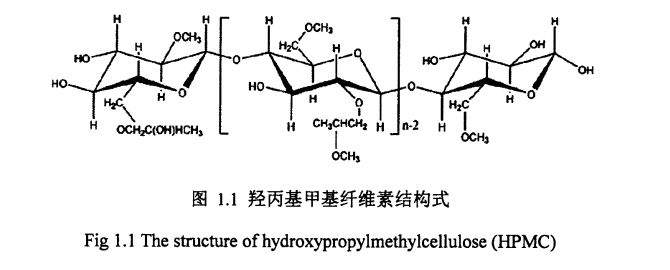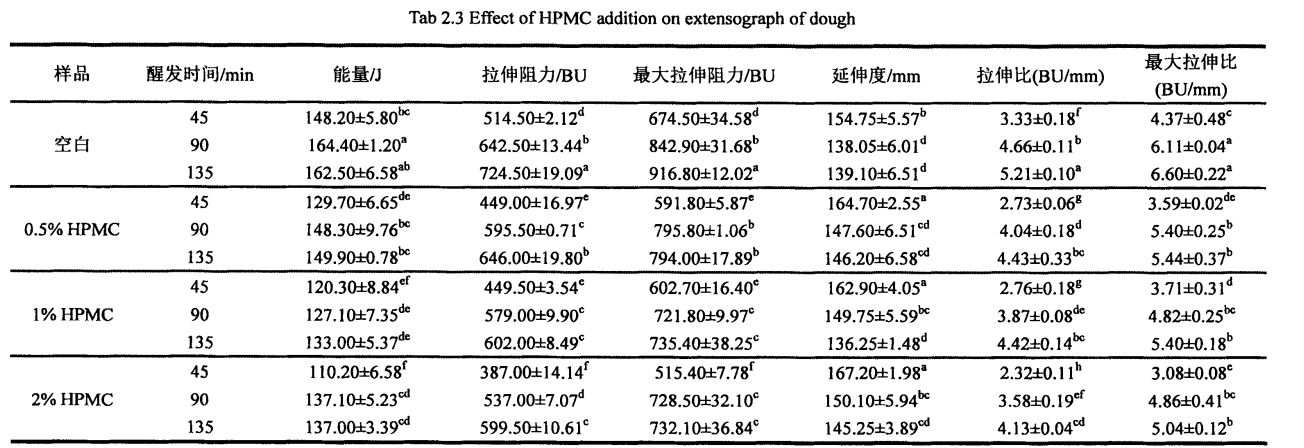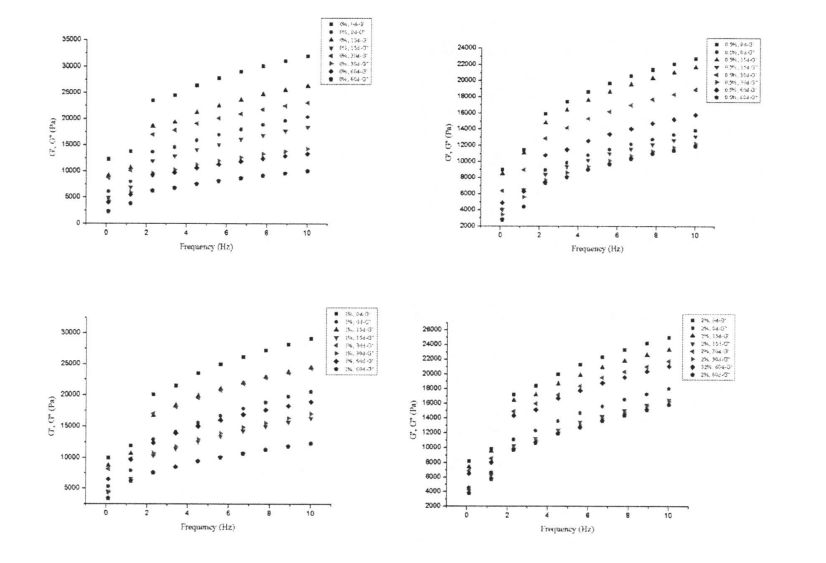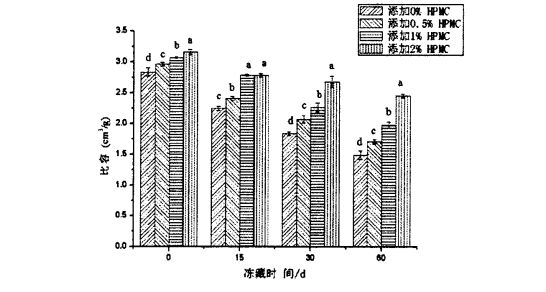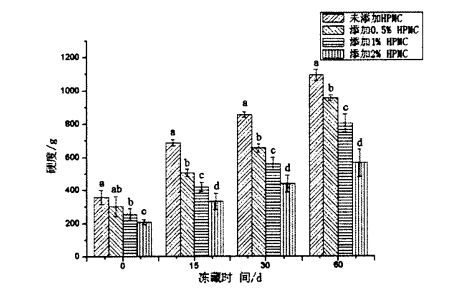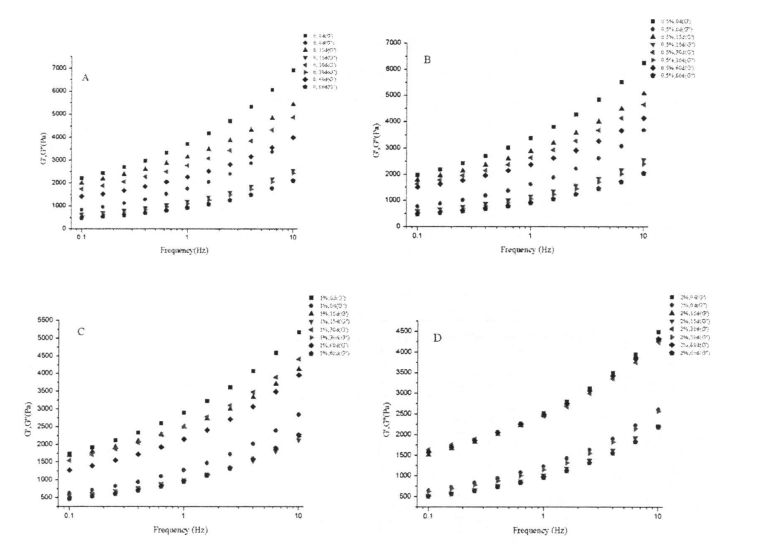Ibisubizo byerekanaga ko HPMC ishobora kongerwaho ifu yakonje nkubwoko bushya bwa ChipOprotecant kugirango butezimbere imitungo yo gutunganya hamwe nubwiza bwumugati uhumeka.
Imbonerahamwe
UMUTWE WA 1 Itangazo ..................................................................................................................................................... 1
1.1.7 Hydroxypropyl methyl cellulose (Hydroxypropyl methyl cellulose, I-IPMC) ………. 5
Intego nakamaro k'ubushakashatsi ................................................................................ 6
2.3 Experimental results and discussion…………………………………………………………………… . 11
2.3.1 Ironderero ryibice byibanze byifu ............................................................................. .1l
3.2.4 Uburyo bugeragezi ............................................................................................................... 25
3.3.2 The effect of adding amount of HPMC and freezing storage time on the freezable moisture content (CFW) and thermal stability……………………………………………………………………. 30
3.3.3 Effects of HPMC addition amount and freezing storage time on free sulfhydryl content (C vessel) …………………………………………………………………………………………………………. . 34
4.1 Introduction .............................................................................................................................. . 44
4.2 Ibikoresho byubushakashatsi nuburyo ............................................................................................. 45
4.2.2 Ibikoresho byubushakashatsi ............................................................................................................ 45
4.2.3 Uburyo bwo kugerageza ........................................................................................................................ 45
4.3 Analysis and discussion ........................................................................................................... 48
4.3.1 Content of basic components of wheat starch ……………………………………………………. 48
4.3.3 Effects of HPMC addition and freezing storage time on the shear viscosity of starch paste………………………………………………………………………………………………………………………………………. 52
4.3.6 Effects of I-IPMC addition amount and frozen storage time on the thermodynamic properties of starch ………………………………………………………………………………………………………. . 57
Chapter 5 Effects of HPMC addition on yeast survival rate and fermentation activity under frozen storage conditions………………………………………………………………………………………………. . 62
5.1Introduction .................................................................................................................................... 62
5.2 Materials and methods ............................................................................................................ 62
5.2.2 Experimental methods . . . . . …………………………………………………………………………. 63
5.3 Results and Discussion ............................................................................................................... 64
5.3.3 The effect of adding amount of HPMC and freezing time on the content of glutathione in dough……………………………………………………………………………………………………………66. "
5.4 Chapter Summary ........................................................................................................................ 67
6.1 Conclusion ................................................................................................................................. . 68
6.2 Outlook .......................................................................................................................................... 68
Figure 1.1 The structural formula of hydroxypropyl methylcellulose………………………. . 6
Figure 2.4 The effect of HPMC addition and freezing time on the elasticity of steamed bread………………………………………………………………………………………………………………………………. . 20
Figure 3.1 The effect of HPMC addition and freezing time on the rheological properties of wet gluten…………………………………………………………………………………………………………………………. 30
Figure 3.2 Effects of HPMC addition and freezing time on the thermodynamic properties of wheat gluten………………………………………………………………………………………………………………. . 34
Figure 3.3 Effects of HPMC addition and freezing time on free sulfhydryl content of wheat gluten……………………………………………………………………………………………………………………………... . 35
Igicapo 3.4 Ingaruka zo Kwiyongera kwa HPMC hamwe nigihe cyo kubikamo ubukonje kugabura igihe cyo kuvugurura (n) cya Gluten ................................................................................. 36
Figure 3.7 The effect of HPMC addition and freezing time on the microscopic gluten network structure…………………………………………………………………………………………………………... . 43
Figure 4.1 Starch gelatinization characteristic curve ............................................................... 51
Figure 4.2 Fluid thixotropy of starch paste ................................................................................. 52
Figure 4.3 Effects of adding amount of MC and freezing time on the viscoelasticity of starch paste……………………………………………………………………………………………………………………... . 57
Figure 4.5 Effects of HPMC addition and freezing storage time on the thermodynamic properties of starch…………………………………………………………………………………………………………. . 59
Igicapo 5.1 Ingaruka za HPMC igihe cyo kwiyongera no gukonjesha igihe cyo kwerekana uburebure bwa dough ................................................................................................................................................... ... 66
Figure 5.2 The effect of HPMC addition and freezing time on the yeast survival rate…………………………………………………………………………………………………………………………………... . 67
Figure 5.3 Microscopic observation of yeast (microscopic examination) …………………………………………………………………………………………………………………………. 68
Imbonerahamwe 2.1 Ibikoresho byibanze byifu byifu ...................................................................... 11
Imbonerahamwe 3.1 Ibikubiye mubintu byibanze muri Gluten ............................................................................. .25
Table 3.2 Effects of I-IPMC addition amount and freezing storage time on the phase transition enthalpy (Yi IV) and freezer water content (e chat) of wet gluten………………………. 31
Table 3.3 Effects of HPMC addition amount and freezing storage time on the peak temperature (product) of thermal denaturation of wheat gluten…………………………………………. 33
Table 3.6 Effects of I-IPMC addition and freezing storage time on the surface hydrophobicity of wheat gluten……………………………………………………………………………………………. 41
Table 4.3 Effects of I-IPMC addition and freezing time on the shear viscosity of wheat starch paste…………………………………………………………………………………………………………………………. 55
1.1.1.
1.1.2Ibyahuye Imiterere yumugati uhumeka
1)Development of new characteristic steamed buns. Through the innovation of steamed bread raw materials and the addition of functional active substances, new varieties of steamed breads have been developed, which have both nutrition and function. Established the evaluation standard for the quality of miscellaneous grain steamed bread by principal component analysis; Fu et a1. (2015) added lemon pomace containing dietary fiber and polyphenols to steamed bread, and evaluated the antioxidant activity of steamed bread; Hao & Beta (2012) studied barley bran and flaxseed (rich in bioactive substances) The production process of steamed bread [5]; Shiau et A1. (2015) evaluated the effect of adding pineapple pulp fiber on dough rheological properties and steamed bread quality [6].
4) Ubushakashatsi kugutezimbere ubuziranenge bwumugati wuzuye. Ubushakashatsi ku kongera no gushyira mu bikorwa imigati yuzuye umutsima; mainly including additives (such as enzymes, emulsifiers, antioxidants, etc.) and other exogenous proteins [14], starch and modified starch [15], etc. The addition and optimization of the corresponding process It is particularly noteworthy that in recent years, through the use of some exogenous proteins and other additives, gluten-free (free. gluten) pasta products have been developed to meet the requirements of celiac disease (Dietary needs of patients with Coeliac Disease [16.1 cit.
Frozen dough is a new technology for the processing and production of flour products developed in the 1950s. It mainly refers to the use of wheat flour as the main raw material and water or sugar as the main auxiliary materials. Bitetse, bipakiye cyangwa bipakiwe, bikonje-byihuse nibindi bikorwa bituma ibicuruzwa bigera kuri leta ikonje, kandi. Kubicuruzwa byanyuma bigomba gukonjeshwa,
Cakes and other pasta products have different degrees of application [26-27]. According to incomplete statistics, by 1990, 80% of bakeries in the United States used frozen dough; 50% of bakeries in Japan also used frozen dough. Ikinyejana cya makumyabiri
1.1.5ReSards Status ya Dozin Frozen
II. Optimization of frozen dough production process, frozen storage conditions and formula. During the production of frozen dough, temperature control, proofing conditions, pre-freezing treatment, freezing rate, freezing conditions, moisture content, gluten protein content, and thawing methods will all affect the processing properties of frozen dough [37]. In general, higher freezing rates produce ice crystals that are smaller in size and more uniformly distributed, while lower freezing rates produce larger ice crystals that are not uniformly distributed. In addition, a lower freezing temperature even below the glass transition temperature (CTA) can effectively maintain its quality, but the cost is higher, and the actual production and cold chain transportation temperatures are usually small. In addition, the fluctuation of the freezing temperature will cause recrystallization, which will affect the quality of the dough.
III. Using additives to improve the product quality of frozen dough. Mu rwego rwo kunoza ubuziranenge bw'ibicuruzwa byafunzwe, abashakashatsi benshi bakoze ubushakashatsi mu bitekerezo bitandukanye, urugero, kunoza ubushyuhe bwo hasi bw'ibice by'ifumbire, n'ibindi muri bo, gukoresha inyongeramu ari byo buryo bwiza kandi bukoreshwa neza kandi bukoreshwa neza kandi bukoreshwa neza kandi bukoreshwa neza kandi bukoreshwa neza kandi bukoreshwa neza kandi bukoreshwa neza kandi bukoreshwa neza kandi bukoreshwa neza kandi bukoreshwa neza kandi bukoreshwa neza kandi bukoreshwa neza kandi bukoreshwa neza kandi bukoreshwa neza. Mainly include, i) enzyme preparations, such as, transglutaminase, O [. Amylase; ii) emulsifiers, such as monoglyceride stearate, DATEM, SSL, CSL, DATEM, etc.; iii) antioxidants, ascorbic acid, etc.; iv) polysaccharide hydrocolloids, such as guar gum, yellow Originalgum, gum Arabic, konjac gum, sodium alginate, etc.; v) Ibindi bintu bikora, nka xu, et a1. .
1.1.6Gusaba Hydrocolloids muri Induru ikonje nziza
1.2Kugamiyeho intego n'akamaro
1.3Ibintu nyamukuru byubushakashatsi
BPS. 500cl guhora ubushyuhe nubushuhe
C21. KT2134 Guteka
Powder meter. E
Extensometer. E
Q200 Imyitozo yo gusikana
FD. 1B. 50 vacuum gukonjesha
Uruganda
Stab Micro Systems, UK
Brabender, Ubudage
Brabender, Ubudage
Huang Shi Heng Feng ibikoresho by'ubuvuzi Cong Co., Ltd.
Muri bo, 厶 yerekana ubushyuhe bwinshi bw'ubushuhe, kandi agaciro kacyo ni 334 Y Dan; MC (total Moisture Content) represents the total moisture content in the dough (measured according to GB 50093.2010t78]). Each sample was repeated three times.
2.2.3.8 Isuzuma ryumugati wuzuye
2.3 Ibisubizo bigeragezwa nibiganiro
2.3.1 Urufatiro rwibanze rwifu
Tab 2.1 Ibirimo byibanze byifu
2.3.5 Ingaruka zo korohereza HPMC hamwe nigihe cyo kubikamo amazi kumazi adahagije (ow) muri dough frozen
Not all the moisture in the dough can form ice crystals at a certain low temperature, which is related to the state of the moisture (free-flowing, restricted, combined with other substances, etc.) and its environment. Freezable water is the water in the dough that can undergo phase transformation to form ice crystals at low temperatures. The amount of freezable water directly affects the number, size and distribution of ice crystal formation. Byongeye kandi, ibirimo amazi atuje nayo bigira ingaruka kubidukikije, nko kwagura igihe cyo kubusa, ihindagurika ryubushyuhe bwo kubikamo, kandi guhindura imiterere yububiko. Kuberako ifu yakonje itayongereyeho HPMC, q Silicon yiyongereye cyane, kuva 32.48 ± 0.32% (kubika byakonje (Ububiko bwa LIFET ( Tibetan for 60 days), the increase rate was 20.47%. Ariko, nyuma yiminsi 60 yububiko bukonje, hamwe no kwiyongera kwa HPMC, umubare wa CFW wagabanutse, ukurikirwa na 18.41%, 13.71%, na 12.48% (Imbonerahamwe (Imbonerahamwe (Imbonerahamwe (Imbonerahamwe 2.48). Muri icyo gihe, O∥ y'ifu idahwitse yagabanutse hamwe no kongera umubare wa HPMC yongeyeho, kuva 32.48a-0.32% (utayongereyeho hpmc) kugeza 31.20 ± 0.20%. (adding0.5% HPMC), 3 1.29+0.03% (adding 1% HPMC) and 30.44±0.03% (adding 2% HPMC) Water holding capacity, inhibits the free flow of water and reduces the amount of water that can be frozen. Muburyo bwo kubika bukonje, hamwe no gusubiramo, imiterere ya dogtstallisation irasenyutse, kugirango igice cyamazi adahagije gihindurwa mumazi adahagije, bityo akayongera ibikubiye mumazi adahagije. Ariko, HPMC irashobora kubuza neza uburyo bwo gushiraho no gukura kwa kirisiti ya karasi no kurinda umutekano wimiterere, bityo bikabuza gutunganya imiterere yimiterere, bityo bikabuza neza imiterere y'amazi adahagije. This is consistent with the change law of the freezable water content in the frozen wet gluten dough, but because the dough contains more starch, the CFW value is smaller than the G∥ value determined by the wet gluten dough (Table 3.2).

On the other hand, with the prolongation of freezing time, the cohesion and restoring force of steamed bread decreased significantly. For steamed bread made from frozen dough without adding HPMC, its cohesion was increased by O. 86-4-0.03 g (frozen storage 0 days) was reduced to 0.49+0.06 g (frozen storage for 60 days), while the restoring force was reduced from 0.48+0.04 g (frozen storage for 0 days) to 0.17±0.01 (frozen storage for 0 days) 60 days); however, for steamed buns made from frozen dough with 2% HPMC added, the cohesion was reduced from 0.93+0.02 g (0 days frozen) to 0.61+0.07 g (frozen storage for 60 days), while the restoring force was reduced from 0.53+0.01 g (frozen storage for 0 days) to 0.27+4-0.02 (frozen storage for 60 days). In addition, with the prolongation of frozen storage time, the stickiness and chewiness of steamed bread increased significantly. For the steamed bread made from frozen dough without adding HPMC, the stickiness was increased by 336.54+37. 24 (0 days of frozen storage) increased to 1232.86±67.67 (60 days of frozen storage), while chewiness increased from 325.76+34.64 (0 days of frozen storage) to 1005.83+83.95 (frozen for 60 days); Ariko, kubera imitwe ihumeka ikozwe mu ifu ya Frozen hamwe na HPMC yakonje 2%, urufatiro rwiyongereye kuva 206.62 + 1 1.84 (gukonjesha iminsi 0) kugeza 472.84. 96. This shows that the addition of HPMC can effectively inhibit the changes in the texture properties of steamed bread caused by freezing storage. Byongeye kandi, impinduka mumitungo yimiterere yumugati uhumeka (nko kwiyongera kwuzuye no kugabanuka kwimbere hamwe niterambere ryimbere hamwe nimpinduka zumugati wuzuye. Rero, imitungo ifu (urugero, ubusabane, kuramba, hamwe nuburyo bwa rubura) burashobora kunozwa ko ifu ya FIRMC yo kongeramo HPMC, na HPMC ihagarika ifu yongeyeho HPMC, kandi yongeranga ifu yo kongeramo hpmc, kandi yongeranga ifu yo kongeramo hpmc kugirango yongereho hpmc kugirango akorwe na hpmc kugirango akorwe na hpmc kugirango akorwe na HPMC.
HydroxyPropyl methylcellse (HPMC) ni ubwoko bwa hydrophilique, hamwe nubushakashatsi bwabwo muri ifu ya Frozen hamwe nibiryo byabashinwa (nkumugati wanyuma) nkuko ibicuruzwa byanyuma biracyabura. The main purpose of this study is to evaluate the effect of HPMC improvement by investigating the effect of HPMC addition on the processing properties of frozen dough and the quality of steamed bread, so as to provide some theoretical support for the application of HPMC in steamed bread and other Chinese-style flour products. Ibisubizo byerekana ko HPMC ishobora guteza imbere imitungo ya farinaceous yifu. Iyo amafaranga yongeyeho HPMC ni 2%, igipimo cyo kwinjiza amazi cyiyongera kuva kuri 58.10% mumatsinda yo kugenzura kugeza 60.60%; 2 min yiyongereye kugera 12.2; Muri icyo gihe, igihe cyo gufu cyagabanutse kuva 2.1 mu itsinda rishinzwe kugenzura kugeza ku ruganda rwa 1.5; the weakening degree decreased from 55 FU in the control group to 18 FU. In addition, HPMC also improved the tensile properties of the dough. With the increase in the amount of HPMC added, the elongation of the dough increased significantly; significantly reduced. In addition, during the frozen storage period, the addition of HPMC reduced the increase rate of the freezable water content in the dough, thereby inhibiting the damage to the dough network structure caused by ice crystallization, maintaining the relative stability of the dough viscoelasticity and the integrity of the network structure, thereby improving the stability of the dough network structure. The quality of the final product is guaranteed.
3.2.2 Ibikoresho byo kugerageza
Discovery. R3 Rheometer
722e SpecThoro
BC / BD. 272SC refrigerator
BCD. Ububiko bwa Refrigetor
Nicolet 67 Bane Mine Yahinduwe Infraret
FD. 1B. 50 vacuum gukonjesha
Uruganda
Shanghai Niumet Sosiyete
Shanghai Spectrum Igikoresho Co, Ltd.
Jintan Jincheng Uruganda rwibikoresho byubushakashatsi
THERMO Fisher, Amerika
THERMO Fisher, Amerika
Icyemezo n'Ubudage
ScilogeX, Amerika
3.2.3 Reagents
3.2.4 Uburyo bwo kugerageza
3.2.4.3 Kwemeza imiterere yuburyo bwa misa itose
Among them, three, represents the latent heat of moisture, and its value is 334 J/g; MC igereranya ibikubiye mubushuhe byuzuye urusaku rutose rwapimwe (rwapimwe ukurikije GB 50093.2010 [. 78]). Each sample was replicated three times.
Muri ubu bushakashatsi, hakoreshejwe uburyo bwa kaburimbo bufite ibikoresho byo kwihatiriranagurika byihariye. Both sample and background collection were scanned 64 times with a resolution of 4 cm~ and a scanning range of 4000 cmq-500 cm~. Spread a small amount of protein solid powder on the surface of the diamond on the ATR fitting, and then, after 3 turns clockwise, you can start to collect the infrared spectrum signal of the sample, and finally get the wavenumber (Wavenumber, cm-1) as the abscissa, and absorbance as the abscissa. (Absorption) is the infrared spectrum of the ordinate.
3.2.4.8 Kwiyemeza hejuru hydrophobicity ya poroteyine ya gluten
Dukurikije uburyo bwa Kato & Nakai (1980) [112], aside ya Naphthalene sulfonic (anphthalene sulfonic (anphthalene sulfonic (anphthalene sulfonic (anphthalene sulfonic (anphthalene sulfonic (anphthalene sulfonic (anphthalene sulfonic (anphthalene sulfonic (anphthalene sulfonic (anphthalene sulfonic (anphthalene sulfonic (anphthalene sulfonic (anphthalene sulfonic (anphthalene sulfonic (anphthalene sulfonic (anphthalene sulfonic (anphthalene sulfonic (anphthalene sulfonic (anphthalene sulfonic. Weigh 100 mg gluten protein solid powder sample, disperse it in 15 mL, 0.2M, pH 7.0 phosphate buffered saline (PBS), stir magnetically for 20 min at room temperature, and then stir at 7000 rpm, 4 " Under the condition of C, centrifuge for 10 min, and take the supernatant. Similarly, use Coomassie brilliant blue method to measure the protein content in the Ikirengagisho, hanyuma ukurikije ibisubizo byo gupima, ikigo ndenga cyavangwa na PBS ku banyeshuri 5 bibanda kuri 5 na hamwe kuri 0.02.0.5 intera.
3.2.4.10 gutunganya amakuru
3. Ibisubizo n'ibiganiro
Igishushanyo cya 3. Ingaruka za HPMC yongeyeho kandi ububiko bwakonje kuri moteri yamashanyarazi ya gluten
3.3

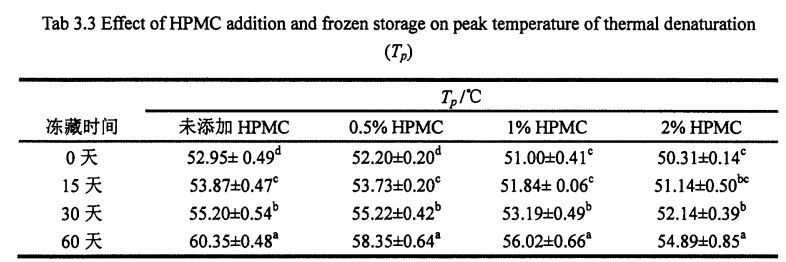
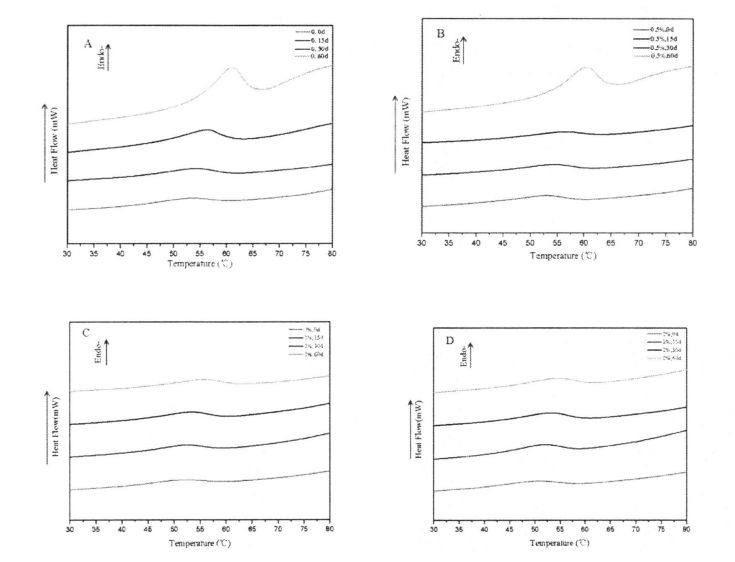
Fig 3.2 Typical DSC thermograms of gluten proteins with 0%HPMC(A);with O.5%HPMC(B); with 1%HPMC(C);with 2%HPMC(D)after different time of frozen storage,from 0d to 60d indicated from the lowest curve to the highest one in each graph. Note: A is the DSC curve of wheat gluten without adding HPMC; B is the addition of O. DSC curve of wheat gluten with 5% HPMC; C is the DSC curve of wheat gluten with 1% HPMC; D is the DSC curve of wheat gluten with 2% HPMC 3.3.3 Effects of HPMC addition amount and freezing time on free sulfhydryl content (C-SH) Intermolecular and intramolecular covalent bonds are very important for the stability of dough network structure. A disulfide bond (-SS-) is a covalent linkage formed by dehydrogenation of two free sulfhydryl groups (.SH). Glutenin is composed of glutenin and gliadin, the former can form intramolecular and intermolecular disulfide bonds, while the latter can only form intramolecular disulfide bonds [1241] Therefore, disulfide bonds are an intramolecular/intermolecular disulfide bond. important way of cross-linking. Compared to adding 0%, O. The C-SH of 5% and 1% HPMC without freezing treatment and the C-SH of gluten after 60 days of freezing have different degrees of increase respectively. Specifically, the face with no HPMC added gluten C. SH increased by 3.74 "mol/g to 8.25 "mol/g, while C.sh, shellfish, with gluten supplemented with 0.5% and 1% HPMC increased by 2.76 "mol/g to 7.25""mol/g and 1.33 "mol/g to 5.66 "mol/g (Fig. 3.3). Zhao, et a1. (2012) found that after 120 days of frozen storage, the content of free thiol groups increased significantly [ 1071. It is worth noting that the C-SH of gluten protein was significantly lower than that of other frozen storage periods when the freezing period was 15 days, which may be attributed to the freezing shrinkage effect of gluten protein structure, which makes the More intermolecular and intramolecular disulfide bonds were locally formed in a shorter freezing time [1161. Wang, et a1. (2014) found that the C-SH of glutenin-rich proteins was also significantly increased after 15 days of freezing. Decreased [1251. However, the gluten protein supplemented with 2% HPMC did not increase significantly except for C-SH, which also decreased significantly at 15 days, with the extension of freezing igihe.
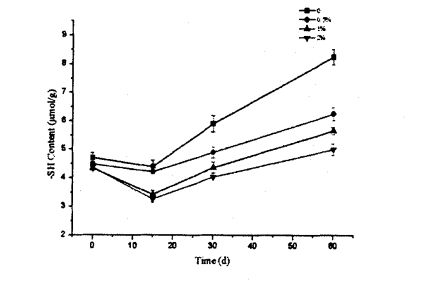
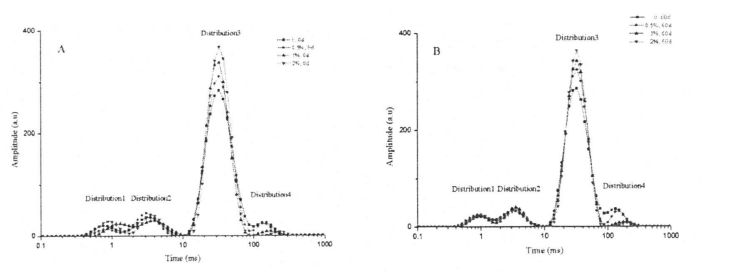

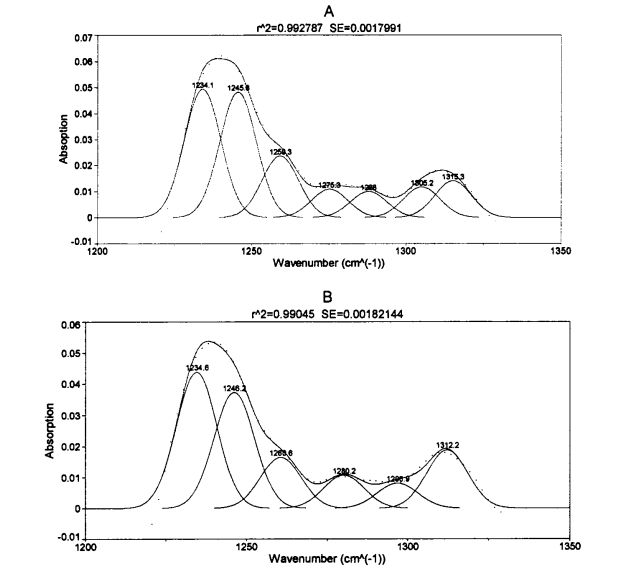
Icyitonderwa: A nigiciro cya infrared cyingano cya gleat poroine udatongeyeho Hpmc muminsi 0 yiminsi 0 yububiko bwakonje; B nigiciro cya infrared cyingano cya gluten proteine yububiko bwakonje kuminsi 0 hamwe na 2% hpmc yongeyeho
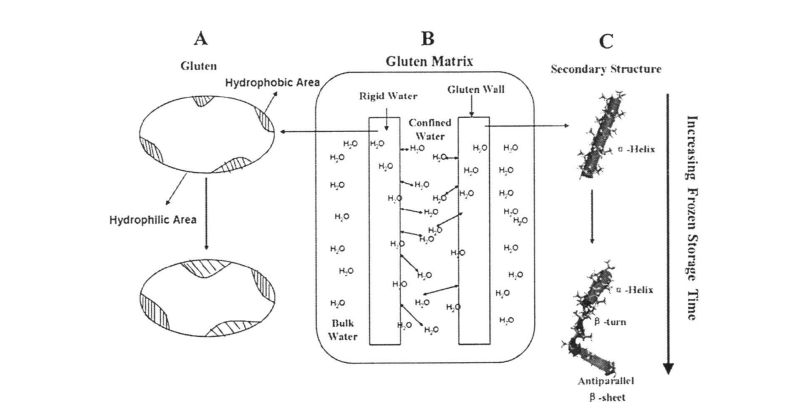
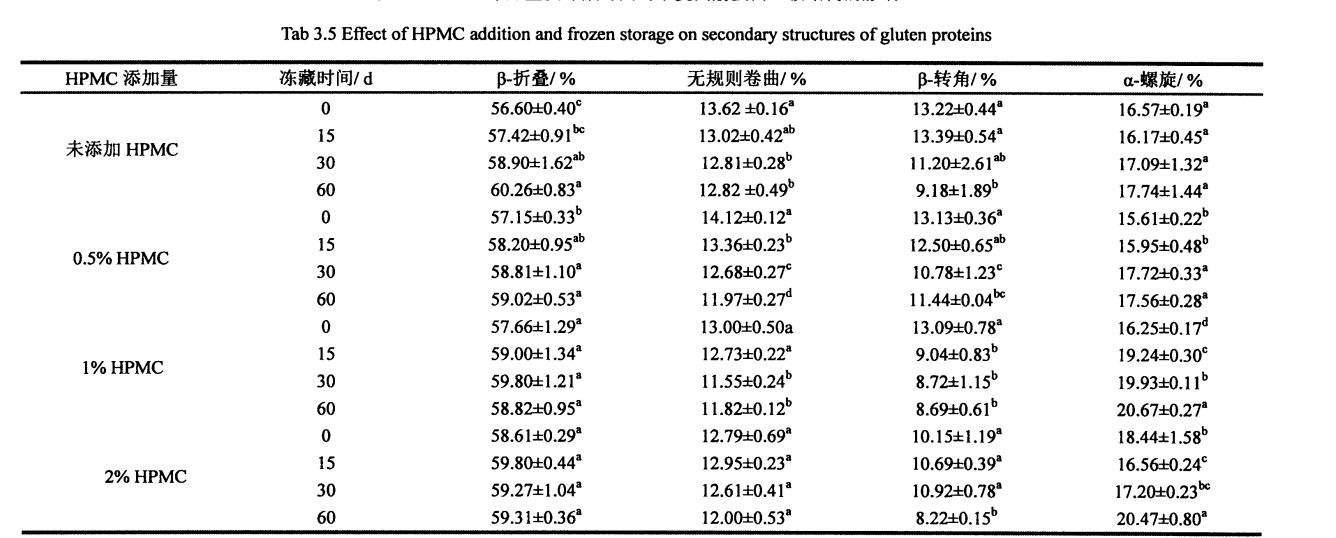

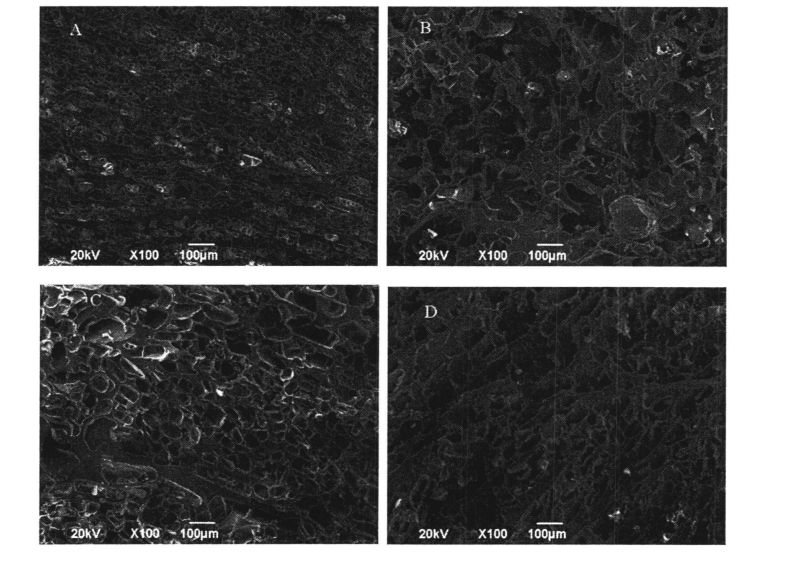
3.4 Umutwe
UMUTWE WA 4 Ingaruka za HPMC YONGEZE KUBIKORWA N'UMUBONA BY'ICYIZA KUGEZA HANZE
4.1 Intangiriro
4.2 ibikoresho byubushakashatsi nuburyo bwiza
4.2.1 Ibikoresho byubushakashatsi
Wheat Starch Binzhou Zhongyu Food Co., Ltd.; HPMC ALDINIM (Shanghai) Chimical Reagent Co, ltd .;
4.2.2 Yamazaki
BSAL24S ZIDASANZWE
BCD-ALLTER
Uruganda
Jiagsu Jinchang Guecheng Uruganda
Itsinda rya Haier
Hefei Meiling Co, Ltd.
4.2.3 Uburyo bwo kugerageza
Shushanya 1.5 ml yibisubizo byicyitegererezo hanyuma ukongereho hagati ya Rheometer Icyitegererezo, upima imitungo ya gelaninisation ukurikije ibipimo bya gahunda yavuzwe haruguru, hanyuma ubone igihe (° C) NK'UBUHANZI BWA SPREINSAIMWE. According to GB/T 14490.2008 [158], the corresponding gelatinization characteristic indicators—gelatinization peak viscosity (field), peak temperature (Ang), minimum viscosity (high), final viscosity (ratio) and decay value (Breakdown) are obtained. Value, BV) and regeneration value (Setback Value, SV), wherein, decay value = peak viscosity - minimum viscosity; setback value = final viscosity - minimum viscosity. Each sample was repeated three times.
The above gelatinized starch paste was subjected to the Steady Flow Test, according to the method of Achayuthakan & Suphantharika [1591, the parameters were set to: Flow Sweep mode, stand at 25°C for 10 min, and the shear rate scan range was 1) 0.1 S one. 100S ~, 2) 100S ~. 0.1 S~, the data is collected in logarithmic mode, and 10 data points (plots) are recorded every 10 times the shear rate, and finally the shear rate (Shear Rate, SI) is taken as the abscissa, and the shear viscosity ( Viscosity, pa ·s) is the rheological curve of the ordinate. Use Origin 8.0 to perform nonlinear fitting of this curve and obtain the relevant parameters of the equation, and the equation satisfies the power law (Power Law), that is, t/=K), nI, where M is the shear viscosity (pa ·s), K is the consistency coefficient (Pa ·s), is the shear rate (s. 1), and n is the flow behavior index (Flow Behavior Index, dimensionless).
4.2.3.3 Starch Passe Gal Ibintu
Fata 1,5 ml yicyitegererezo hanyuma ubishyire kumurongo wicyitegererezo wa Rheometer (Ubuvumbuzi. Kurimbuka The temperature scan starts at 25°C and ends at 5. C/min was raised to 95°C, kept for 2 min, and then lowered to 25°C at 5"C/min.
4.2.3.7 Isesengura ryamakuru no gutunganya

Imbonerahamwe 4.2 Andika ingaruka zibipimo byinshi byingenzi byerekana ibiranga imitsi ya Strarch, harimo na Gelatinisation Peak victosity, viccosity ntarengwa, kandi igaragaza ingaruka za HPMC yongeyeho na STRARY. ingaruka za shimi. The experimental results show that the peak viscosity, the minimum viscosity and the final viscosity of starch without frozen storage increased significantly with the increase of HPMC addition, while the decay value and recovery value decreased significantly. Specifically, the peak viscosity gradually increased from 727.66+90.70 CP (without adding HPMC) to 758.51+48.12 CP (adding 0.5% HPMC), 809.754-56.59 CP (adding 1 %HPMC), and 946.64+9.63 CP (adding 2% HPMC); the minimum viscosity was increased from 391.02+18.97 CP (blank not adding) to 454.95+36.90 (adding O .5% HPMC), 485.56+54.0.5 (add 1% HPMC) and 553.03+55.57 CP (add 2% HPMC); the final viscosity is from 794.62.412.84 CP ( Without adding HPMC) increased to 882.24±22.40 CP (adding 0.5% HPMC), 846.04+12.66 CP (adding 1% HPMC) and 910.884-34.57 CP (adding 2 %HPMC); however, the attenuation value gradually decreased from 336.644-71.73 CP (without adding HPMC) to 303.564-11.22 CP (adding 0.5% HPMC), 324.19±2.54 CP (Add
On the other hand, when the amount of HPMC added was the same, the peak viscosity, minimum viscosity, final viscosity, decay value and retrogradation value of starch gelatinization increased significantly with the extension of freezing storage time. Specifically, the peak viscosity of starch suspension without adding HPMC increased from 727.66±90.70 CP (frozen storage for 0 days) to 1584.44+68.11 CP (frozen storage for 60 days); adding 0.5 The peak viscosity of starch suspension with %HPMC increased from 758.514-48.12 CP (freezing for 0 days) to 1415.834-45.77 CP (freezing for 60 days); Guhagarika ibinyamisomo hamwe na 1% HPMC yongeyeho urugwiro rwamazi ya Strarch yiyongereye kuva 809.755-56.59 cp (kubika 78.13 cp (kubika gukonjesha iminsi 60); Mugihe ibipimo byahagaritswe hamwe na 2% HPMC yongeyeho viak stak viak viak viscosity kuva 946.64 ± 9.63 cp (iminsi 0 yakonje) yiyongereye kugeza 1240.6 CP (iminsi 60 yakonje). At the same time, the lowest viscosity of starch suspension without HPMC was increased from 391.02-41 8.97 CP (freezing for 0 days) to 556.77±29.39 CP (freezing for 60 days); adding 0.5 The minimum viscosity of the starch suspension with %HPMC increased from 454.954-36.90 CP (freezing for 0 days) to 581.934-72.22 CP (freezing for 60 days); Ibice byahagaritswe hamwe na 1% HPMC yongeyeho ko amazi make yiyongereye kuva 485.5645.05 CP (FreeZing iminsi 0) kugeza 625.484-7 cp (gukonjesha iminsi 60); Mugihe ibipimo byahagaritswe byongeweho 2% HPMC CP gelasinizes decosity scosity yiyongereye kuva 553.034-55.57 CP (iminsi 0 yakonje) kugeza 682.29 CP (iminsi 60 irakonje).

P (kubika gukonjeshwa muminsi 0) kugeza 856.38 ± 16.20 cp (kubika gukonjesha iminsi 60); the retrogradation value of starch suspension added with 0.5% HPMC increased from 427 .29±14.50 CP (frozen storage for 0 days) increased to 740.93±35.99 CP (frozen storage for 60 days); the retrogradation value of starch suspension added with 1% HPMC increased from 360.48±41. 39 CP (frozen storage for 0 days) increased to 666.46 ± 21.40 CP (frozen storage for 60 days); while the retrogradation value of starch suspension added with 2% HPMC increased from 357.85 ± 21.00 CP (frozen storage for 60 days). 0 days) increased to 515.51 ± 20.86 CP (60 days frozen).



However, with the prolongation of freezing storage time, the values of K and n increased to different degrees, among which the value of K increased from 78.240 ± 1.661 Pa·sn (unadded, 0 days) to 95.570 ± 1, respectively. 2.421 Pa·sn (no addition, 60 days), increased from 65.683±1.035 Pa ·S n (addition of O. 5% HPMC, 0 days) to 51.384±1.350 Pa ·S n (Add to 0.5% HPMC, 60 days), increased from 43.122±1.047 Pa ·sn (adding 1% HPMC, 0 days) to 56.538±1.378 Pa ·sn (adding 1% HPMC, 60 days) ), and increased from 13.926 ± 0.330 Pa ·sn (adding 2% HPMC, 0 days) to 16.064 ± 0.465 Pa ·sn (adding 2% HPMC, 60 days); 0.277 ± 0.011 (without adding HPMC, 0 days) rose to O. 334±0.014 (no addition, 60 days), increased from 0.310±0.009 (0.5% HPMC added, 0 day) to 0.336±0.014 (0.5% HPMC added, 60 days), from 0.323 ± 0.013 (add 1% HPMC, 0 days) to 0.340 ± 0.013 (add 1% HPMC, 60 days), and from 0.431 ± 0.013 (add 1% HPMC, 60 days) 2% HPMC, 0 days) to 0.404+0.020 (add 2% HPMC, 60 days). By comparison, it can be found that with the increase of the addition amount of HPMC, the change rate of K and Knife value decreases successively, which shows that the addition of HPMC can make the starch paste stable under the action of shearing force, which is consistent with the measurement results of starch gelatinization characteristics. bihamye.

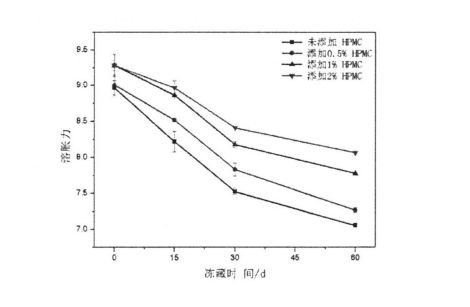
Igishushanyo cya 4.4 Ingaruka za HPMC yongeyeho kandi ububiko bwakonje ku mbaraga zibyimba
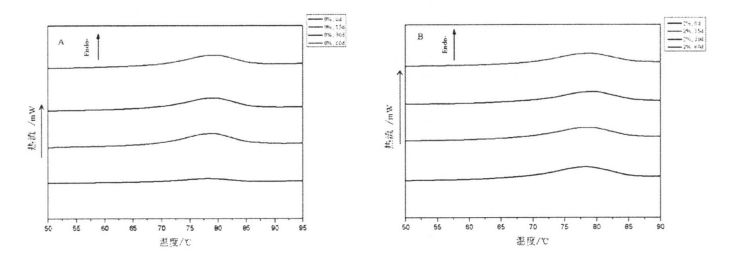
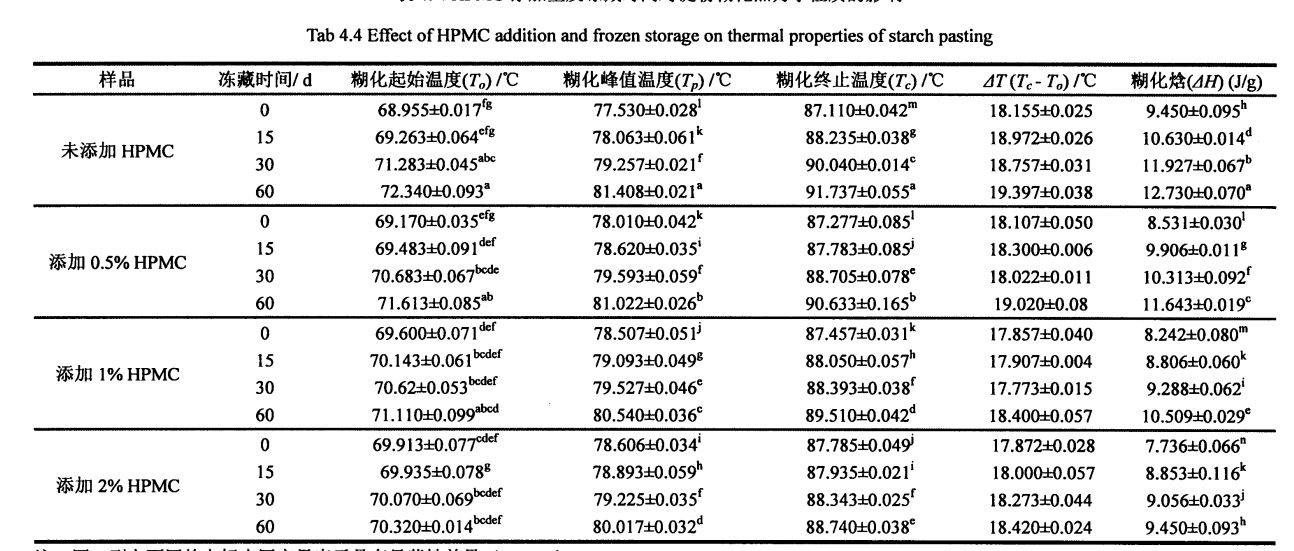
On the other hand, starch gelatinization To, T p, Tc, △T and △Hall increased with the extension of freezing time. Specifically, starch gelatinization with 1% or 2% HPMC added had no significant difference after freezing for 60 days, while starch without or with 0.5% HPMC was added from 68.955±0.01 7 (frozen storage for 0 days) increased to 72.340 ± 0.093 (frozen storage for 60 days), and from 69.170 ± 0.035 (frozen storage for 0 days) to 71.613 ± 0.085 (frozen storage for 0 days) 60 days); after 60 days of frozen storage, the growth rate of starch gelatinization decreased with the increase of HPMC addition, such as starch without HPMC added from 77.530 ± 0.028 (frozen storage for 0 days) to 81.028. 408 ± 0.021 (frozen storage for 60 days), while the starch added with 2% HPMC increased from 78.606 ± 0.034 (frozen storage for 0 days) to 80.017 ± 0.032 (frozen storage for 60 days). days); in addition, ΔH also showed the same change rule, which increased from 9.450 ± 0.095 (no addition, 0 days) to 12.730 ± 0.070 (no addition, 60 days), respectively, from 8.450 ± 0.095 (no addition, 0 days) to 12.730 ± 0.070 (no addition, 60 days), respectively. 531 ± 0.030 (add 0.5%, 0 days) to 11.643 ± 0.019 (add 0.5%, 60 days), from 8.242 ± 0.080 (add 1%, 0 days) to 10.509 ± 0.029 (add 1%, 60 days), and from 7.736 ± O. 066 (2% addition, 0 days) rose to 9.450 ± 0.093 (2% addition, 60 days). The main reasons for the above-mentioned changes in the thermodynamic properties of starch gelatinization during the frozen storage process are the formation of damaged starch, which destroys the amorphous region (amorphous region) and increases the crystallinity of the crystalline region. The coexistence of the two increases the relative crystallinity of starch, which in turn leads to an increase in thermodynamic indexes such as starch gelatinization peak temperature and gelatinization enthalpy. However, through comparison, it can be found that under the same freezing storage time, with the increase of HPMC addition, the increase of starch gelatinization To, T p, Tc, ΔT and ΔH gradually decreases. Birashobora kugaragara ko kongeramo HPMC bushobora gukomeza neza umutekano uhagaze neza kumiterere ya kirisiti, bityo ibuza kwiyongera kwimitungo ya StMornadic ya Strarchy.
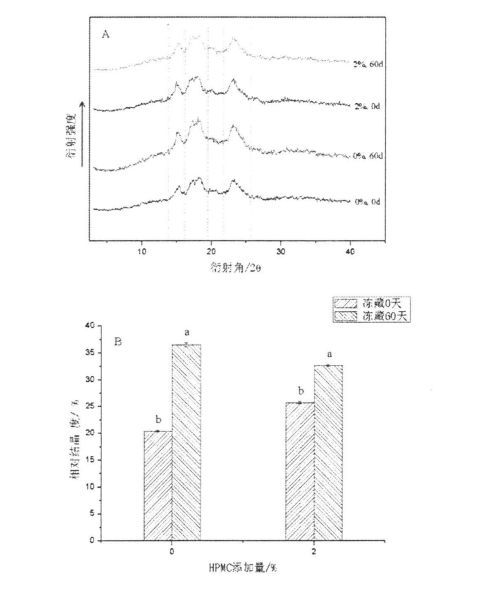
4.4 UMUTWE WA GIKURIKIRA
5.1 Intangiriro
5.2 Ibikoresho nuburyo
5.2.1 Ibikoresho byubushakashatsi nibikoresho
BPS. 500cl guhora ubushyuhe nubushuhe
SP. Icyitegererezo 754 UV Spectraprotometero
Zwy-240 Guhora Ubushyuhe Incubator
Uruganda
Ibikoresho bya Jiagsu Toland Gusukura Co., Ltd.
5.2.2 Uburyo bwo kugerageza
5.2.2.1 Gutegura amazi yumusemburo
5.2.2.2
5.2.2.4 Kwiyegurira Glutothione

As shown in Figure 5.1, when frozen for 0 days, with the increase in the amount of HPMC added, the proofing height of the dough increased from 4.234-0.11 cm to 4.274 cm without adding HPMC. -0.12 CM (0.5% HPMC yongeyeho), 4.314-0.19. 1% However, after being frozen for 60 days, the proofing height of the dough decreased to varying degrees. Specifically, the proofing height of the dough without HPMC was reduced from 4.234-0.11 cm (freezing for 0 days) to 3 .18+0.15 cm (frozen storage for 60 days); Ifu yongeweho 0.5% HPMC yagabanutse guhera 4.27 + 0.12 (kubika gukonjeshwa muminsi 0) kugeza kuri 3.424-0.22 cm (kubika gukonjeshwa muminsi 0). 60 days); the dough added with 1% HPMC decreased from 4.314-0.19 cm (frozen storage for 0 days) to 3.774-0.12 cm (frozen storage for 60 days); while the dough added with 2% HPMC woke up. The hair height was reduced from 4.594-0.17 cm (frozen storage for 0 days) to 4.09-±0.16 cm (frozen storage for 60 days). It can be seen that with the increase of the addition amount of HPMC, the degree of decrease in the proofing height of the dough gradually decreases. This shows that under the condition of frozen storage, HPMC can not only maintain the relative stability of the dough network structure, but also better protect the survival rate of yeast and its fermentation gas production activity, thereby reducing the quality deterioration of fermented noodles.
5.3.2 Ingaruka ya I-Ipmc yongeyeho nigihe cyo gukonjesha ku musemburo urokoka
Kubijyanye no kubika gukonjesha, kubera ko amazi yakonje muri gahunda y'ifu ihindurwa muri kanseri ya ice ihindurwa muri kaburimbo, igitutu cya osmotike hanze yingirabuzimafatizo byiyongereye, kuburyo protoplasts yimisemburo ihangayitse. When the temperature is lowered or kept at low temperature for a long time, a small amount of ice crystals will appear in the yeast cells, which will lead to the destruction of the cell structure of the yeast, the extravasation of the cell fluid, such as the release of the reducing substance - glutathione, or even complete death; at the same time, the yeast Under environmental stress, its own metabolic activity will be reduced, and some spores will be produced, which will reduce the fermentation gas production activity of yeast.
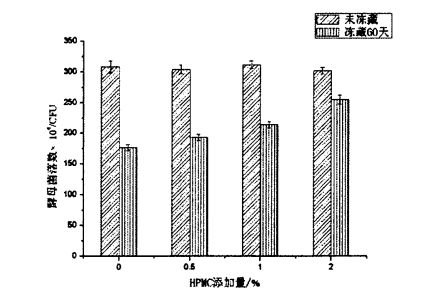
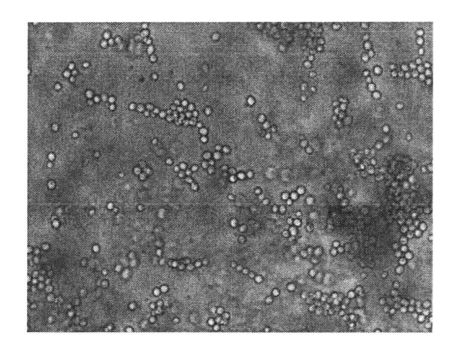
Igishushanyo cya 53 micrograf yimyanya
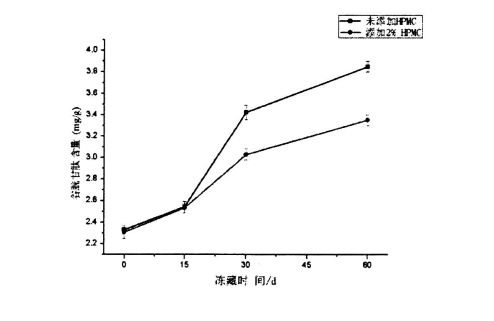
5.4 Umutwe
Igihe cyagenwe: Ukwakira-08-2022







